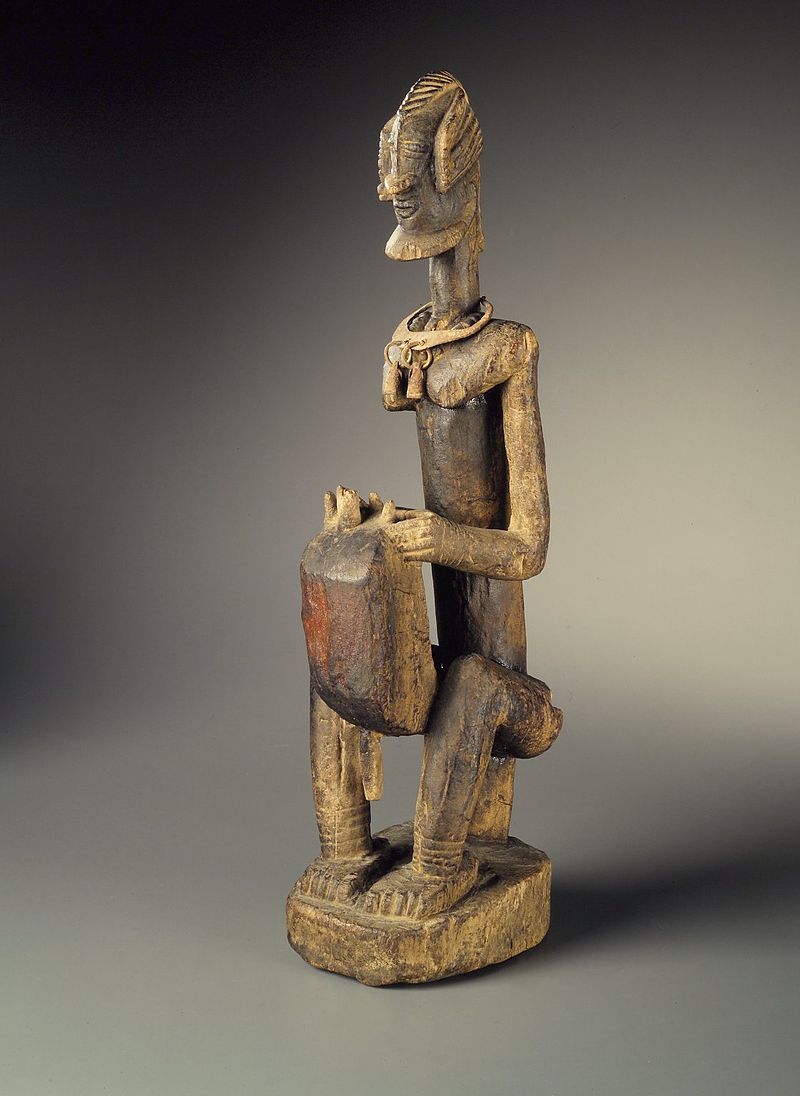The Dogon are an ethnic group living in the central plateau region of Mali, in West Africa, south of the Niger bend, near the city of Bandiagara, and in Burkina Faso. The population numbers between 400,000 and 800,000.[1] They speak the Dogon languages, which are considered to constitute an independent branch of the Niger–Congo language family, meaning that they are not closely related to any other languages.[2]
The Dogon are best known for their religious traditions, their mask dances, wooden sculpture, and their architecture. Since the twentieth century, there have been significant changes in the social organisation, material culture and beliefs of the Dogon, in part because Dogon country is one of Mali’s major tourist attractions.[3]
The principal Dogon area is bisected by the Bandiagara Escarpment, a sandstone cliff of up to 500 m (1,640.42 ft) high, stretching about 150 km (90 miles). To the southeast of the cliff, the sandy Séno-Gondo Plains are found, and northwest of the cliff are the Bandiagara Highlands. Historically, Dogon villages were established in the Bandiagara area a thousand years ago because the people collectively refused to convert to Islam and retreated from areas controlled by Muslims. [4]
Dogon insecurity in the face of these historical pressures caused them to locate their villages in defensible positions along the walls of the escarpment. The other factor influencing their choice of settlement location was access to water. The Niger River is nearby and in the sandstone rock, a rivulet runs at the foot of the cliff at the lowest point of the area during the wet season.
Among the Dogon, several oral traditions have been recorded as to their origin. One relates to their coming from Mande, located to the southwest of the Bandiagara escarpment near Bamako. According to this oral tradition, the first Dogon settlement was established in the extreme southwest of the escarpment at Kani-Na. [5] [6] Archaeological and ethnoarchaeological studies in the Dogon region have been especially revealing about the settlement and environmental history, and about social practices and technologies in this area over several thousands of years. [7][8][9]
Over time, the Dogon moved north along the escarpment, arriving in the Sanga region in the 15th century.[10] Other oral histories place the origin of the Dogon to the west beyond the river Niger, or tell of the Dogon coming from the east. It is likely that the Dogon of today are descendants of several groups of diverse origin who migrated to escape Islamization.[11]
It is often difficult to distinguish between pre-Muslim practices and later practices. But Islamic law classified the Dogon and many other ethnicities of the region (Mossi, Gurma, Bobo, Busa and the Yoruba) as being within the non-canon dar al-harb and consequently fair game for slave raids organized by merchants.[12] As the growth of cities increased, the demand for slaves across the region of West Africa also increased. The historical pattern included the murder of indigenous males by raiders and enslavement of women and children.[13]
Dogon art is primarily sculpture. Dogon art revolves around religious values, ideals, and freedoms (Laude, 19). Dogon sculptures are not made to be seen publicly, and are commonly hidden from the public eye within the houses of families, sanctuaries, or kept with the Hogon (Laude, 20). The importance of secrecy is due to the symbolic meaning behind the pieces and the process by which they are made.
Themes found throughout Dogon sculpture consist of figures with raised arms, superimposed bearded figures, horsemen, stools with caryatids, women with children, figures covering their faces, women grinding pearl millet, women bearing vessels on their heads, donkeys bearing cups, musicians, dogs, quadruped-shaped troughs or benches, figures bending from the waist, mirror-images, aproned figures, and standing figures (Laude, 46–52).
Signs of other contacts and origins are evident in Dogon art. The Dogon people were not the first inhabitants of the cliffs of Bandiagara. Influence from Tellem art is evident in Dogon art because of its rectilinear designs (Laude, 24).
By Africanews with CORRESPONDENT
Last updated: 02/02/2016
MALI
The first edition of the Dogon cultural festival was launched on January 29 in Mali’s capital, Bamako.
It was held on the banks of River Niger opposite the BCEAO Tower in the country.
The three day event organised by TOGUNA in partnership with GINNA DOGON came to a close on the afternoon of Sunday, January 31.
In attendance was the country’s Minister of Culture, Handicrafts and Tourism, N’Diaye Ramatoulayé Diallo and President of the Ginna Dogon tribe, Mamadou Togo.
The major aim of the festival was to promote the cultural diversity of the ancient tribe. The Dogon culture is also one of Mali’s major tourist attractions.
The Dogon are an ethnic group living in the central plateau region of the country of Mali, in Western Africa, south of the Niger bend, near the city of Bandiagara, in the Mopti region.
The Dogon culture is known for its detailed, meaningful art and tribal customs, but the Dogon are mostly known for their ancient, accurate cosmology and the legends of their ancestors from Sirius.
Their origin is however unknown.
They apparently originated from the West bank of the Niger, fleeing from the Mossi people around 1490 and taking refuge in the hills of Bandiagara where they have continued to live resisting being conquered by first the Muslims and then the French.
It is estimated they are less than 800,000 in number.
2011 documentary
2016 documentary
Opinion;
America and the world don’t benefit from showing you Africa rich and beautiful growing. It only shows you old Africa and traditional Africa. Just how America built up China and built the company over there to build their middle class, American Refuses to help Africa unless they can exploit it. The same way Yemen is in the middle of civil now with Russia they are starving and in the worst condition. This is how America shows Africa. This mess needs to stop!


